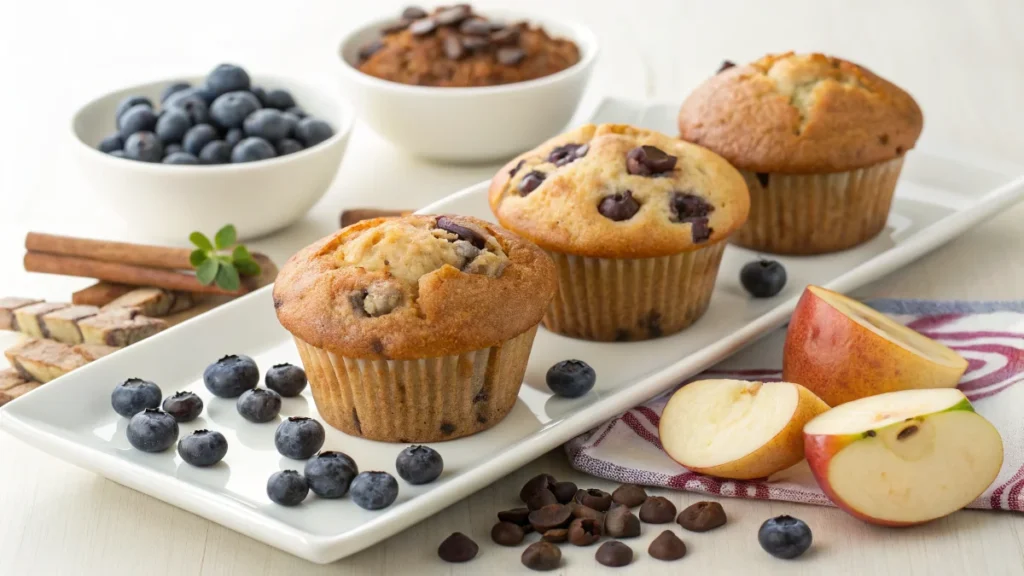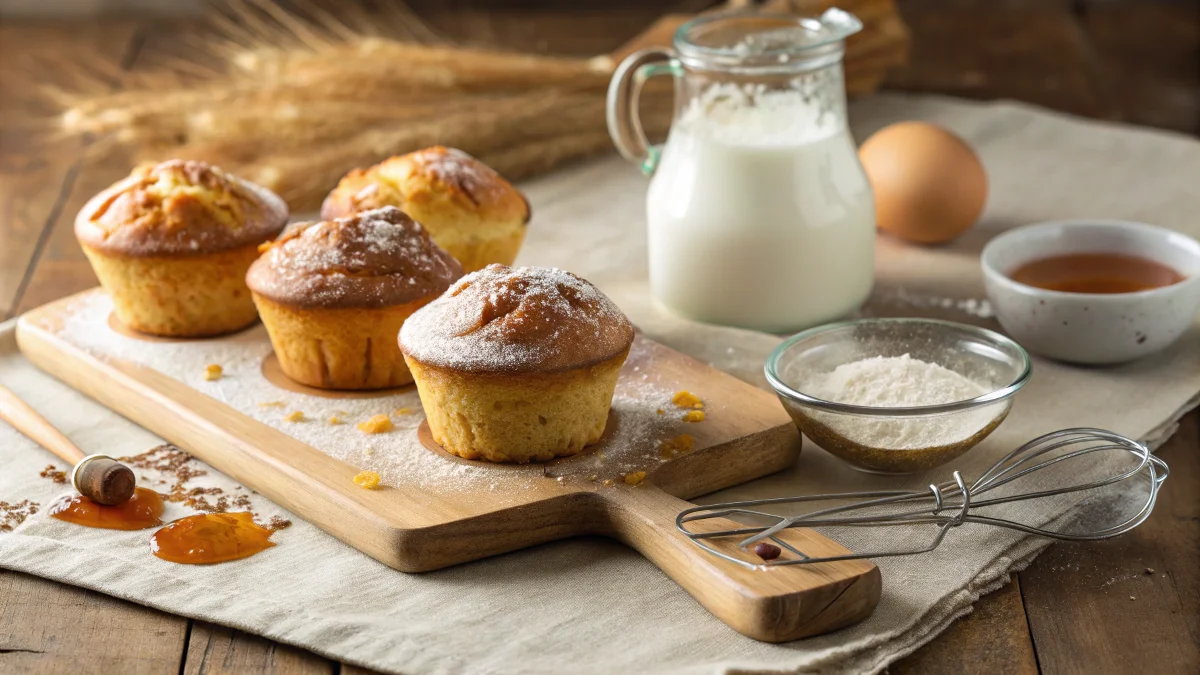Have you ever opened your fridge to find your milk has gone sour? Before tossing it, consider this: Sour Milk in Muffins can be your secret weapon for making moist, tender, and flavorful baked treats. Whether you’re an experienced baker or just exploring ways to reduce food waste, baking with sour milk in muffins is a smart and tasty choice.. In fact, there are many ways to transform sour milk into delightful creations, as highlighted in these Sour Milk Dessert Recipes. In this article, we’ll explore what makes sour milk special for baking, the science behind its role in recipes, and how to use it safely. Let’s dive in!

Table of Contents
What Is Sour Milk and Why Is It Used in Baking?
Understanding Sour Milk
Sour milk in muffins is milk that has naturally turned slightly acidic due to lactic acid bacteria. This process happens when milk is left out for a bit too long or intentionally soured by adding lemon juice or vinegar, making it ideal for baking.
It’s important to note that sour milk in muffins is different from spoiled milk. Sour milk has a tangy but pleasant smell, while spoiled milk smells rancid and often shows visible signs of mold or excessive curdling, making it unsafe for baking.
Why Use Sour Milk in Baking?
Sour milk works wonders in baking for a few key reasons:
- Acidity for Leavening: The acidity of sour milk reacts with baking soda or baking powder, releasing carbon dioxide that helps muffins rise.
- Texture Improvement: The acid in sour milk breaks down gluten, resulting in softer, fluffier baked goods.
- Flavor Enhancement: Sour milk gives a subtle tanginess that complements the sweetness of muffins, balancing flavors perfectly.
How Is Sour Milk Different from Buttermilk?
Both sour milk in muffins and buttermilk add acidity to baked goods, but they differ slightly. Buttermilk is intentionally cultured, while sour milk in muffins develops its acidity naturally or through added acids like vinegar. The two can often be used interchangeably in muffin recipes for similar results.
Benefits of Using Sour Milk in Muffins
Why Bake Muffins with Sour Milk?
If you’re skeptical about baking with sour milk, consider these benefits:
- Prevents Waste: Using sour milk reduces food waste, turning something you’d usually throw away into a delicious treat.
- Economical Option: Instead of buying buttermilk or other specialty ingredients, sour milk serves as an affordable alternative.
- Enhanced Muffin Quality: The acidic properties of sour milk in muffins result in a better rise, improved texture, and enhanced flavor, making it a perfect ingredient for delicious baked goods.
Key Nutritional Insights
Sour milk in muffins retains most of the nutrients found in fresh milk, including calcium, protein, and vitamins. Additionally, the fermentation process can introduce beneficial bacteria, which may promote gut health, making sour milk in muffins a nutritious and flavorful option for baking.
Real-Life Baking Example
In a classic muffin recipe, replacing regular milk with sour milk in muffins can lead to noticeable improvements in the final product. You can expect muffins that are fluffier, with a hint of tang that pairs beautifully with fruits like blueberries or spices like cinnamon. And while you’re at it, why not pair your muffins with a cozy cup of hot chocolate for the perfect comfort food combination?
How Sour Milk Works in Baking
The Science Behind Sour Milk and Baking Soda
The magic of sour milk in muffins lies in its acidity. When combined with baking soda, a chemical reaction occurs, producing carbon dioxide bubbles. These bubbles get trapped in the batter, causing it to expand and rise in the oven. The result? Light, airy sour milk muffins with a perfect crumb.
Improved Texture and Moisture
The acidity in sour milk in muffins interacts with the proteins in flour, breaking them down slightly. This process softens the batter, resulting in muffins that are tender, moist, and incredibly delicious.
Flavor Profile: Subtle Tanginess
The natural tanginess of sour milk in muffins enhances their overall flavor, perfectly balancing out the sweetness. This is especially true for recipes that feature bold flavors like chocolate, citrus, or spices, making sour milk in muffins a versatile and flavorful choice.
Substituting Sour Milk in Recipes
If you don’t have sour milk on hand, you can make your own by adding 1 tablespoon of lemon juice or vinegar to 1 cup of milk. Let it sit for 5–10 minutes until it curdles slightly.

How to Tell the Difference Between Sour Milk and Spoiled Milk
Sour Milk vs. Spoiled Milk
It’s essential to know the difference between sour and spoiled milk to ensure safety in baking.
- Sour Milk: Smells tangy but not offensive. It has a thin, slightly curdled texture and is free of visible mold. Sour milk is safe for baking and can even add value to your recipes.
- Spoiled Milk: Smells rancid or putrid and may have a chunky or slimy consistency. If the milk has visible mold or discoloration, it is spoiled and should be discarded immediately.
Simple Tests to Check Milk Freshness
- Smell Test: Sour milk has a tangy odor, while spoiled milk smells foul and rotten.
- Visual Check: Sour milk may have slight curdling, but spoiled milk often has chunks, mold, or an unappealing color.
- Taste Test (Optional): If you’re still unsure, take a small taste. Sour milk will taste tangy, while spoiled milk will taste off-putting and unpleasant.
Step-by-Step Guide to Baking Muffins with Sour Milk
Gather Your Ingredients
To bake sour milk muffins, you’ll need the following:
- 1 cup sour milk (or homemade sour milk using lemon juice/vinegar)
- 2 cups all-purpose flour
- 1 teaspoon baking soda
- ½ teaspoon salt
- ½ cup sugar (adjust to taste)
- 1 egg
- ½ cup melted butter or vegetable oil
- Optional mix-ins: blueberries, chocolate chips, or nuts
Step-by-Step Instructions
- Preheat and Prep: Preheat your oven to 375°F (190°C) and grease a muffin tin or line it with paper liners.
- Mix Dry Ingredients: In a large bowl, combine flour, baking soda, salt, and sugar.
- Combine Wet Ingredients: In a separate bowl, whisk together sour milk, egg, and melted butter.
- Combine Wet and Dry: Gradually fold the wet mixture into the dry ingredients. Avoid overmixing; a few lumps are fine.
- Add Mix-Ins: Gently fold in your chosen mix-ins, such as berries or nuts.
- Fill the Tin: Fill each muffin cup about ¾ full.
- Bake: Bake for 18–22 minutes, or until a toothpick inserted into the center comes out clean.
- Cool and Serve: Allow muffins to cool in the tin for 5 minutes before transferring them to a wire rack.
Tips for Perfect Muffins
- Do not overmix; this can make the muffins dense.
- Use fresh sour milk for the best results.
- Adjust sweetness and mix-ins based on your preferences.
Common Mistakes When Using Sour Milk in Baking
Overusing Sour Milk in Recipes
One of the biggest mistakes is using too much sour milk in a recipe. Adding excessive sour milk can overpower the flavor of your muffins, making them too tangy or acidic. Always stick to the quantity recommended in your recipe.
Skipping the Baking Soda
Sour milk in muffins requires a base like baking soda to create the chemical reaction that helps the muffins rise. Without baking soda, your muffins may turn out flat and dense. To achieve the perfect texture, always ensure you include this crucial ingredient when baking with sour milk in muffins.
Not Checking if the Milk Is Spoiled
Another common mistake is failing to differentiate between sour milk in muffins and spoiled milk. Using milk that has gone rancid will ruin the taste of your muffins and could pose a health risk. Always conduct a quick smell, visual, or taste test to confirm its quality before baking with sour milk in muffins.
Overmixing the Batter
When using sour milk, it’s essential not to overmix the batter. Overmixing activates gluten in the flour, resulting in dense muffins instead of the light, fluffy texture you want. To expand your baking skills, explore these Eclair Icing and Baking Secrets: Everything You Need to Know About Eclairs for expert tips and inspiration.
Popular Muffin Recipes Using Sour Milk
1. Classic Blueberry Sour Milk Muffins
Blueberry muffins get an upgrade with sour milk in muffins, making them extra moist and fluffy. The tanginess of the sour milk in muffins complements the sweetness of the blueberries perfectly.
2. Chocolate Chip Sour Milk Muffins
Sour milk enhances the chocolatey richness of these muffins while keeping the crumb tender. A sprinkle of chocolate chips on top before baking adds a finishing touch.
3. Cinnamon Apple Sour Milk Muffins
Warm cinnamon and sweet apple chunks pair beautifully with sour milk to create muffins that are perfect for fall mornings.
4. Banana Sour Milk Muffins
If you have overripe bananas and sour milk on hand, this recipe is a must-try. The combination yields moist, flavorful muffins with just the right amount of sweetness.
5. Lemon Poppy Seed Sour Milk Muffins
The tanginess of sour milk in muffins pairs wonderfully with fresh lemon zest and poppy seeds, creating a bright and zesty muffin perfect for brunch.

Can You Use Sour Raw Milk in Baking?
What Is Sour Raw Milk?
Sour raw milk is unpasteurized milk that has naturally turned acidic due to fermentation. Unlike pasteurized milk, which is treated to kill bacteria, sour raw milk in muffins retains its natural enzymes and probiotics, making it a beneficial and flavorful option for baking.
Is Sour Raw Milk Safe for Baking?
Yes, sour raw milk is safe to use in baking as long as it hasn’t spoiled. Like sour pasteurized milk, sour raw milk in muffins adds acidity, enhancing the rise and texture of baked goods. Ensure that the milk smells tangy (not rancid) and has no visible signs of mold before using it.
The Benefits of Baking with Sour Raw Milk
- Flavor: Sour raw milk has a rich, complex flavor that adds depth to your muffins.
- Nutrition: Raw milk contains beneficial bacteria and enzymes that may remain intact during the baking process.
- Texture: The natural acidity helps break down gluten, resulting in soft and tender muffins.
Precautions When Using Sour Raw Milk
If you’re new to using raw milk, start by testing small quantities in recipes to ensure you’re comfortable with its flavor and results. Always store raw milk properly to prevent spoilage.

Expert Tips for Perfect Sour Milk Muffins
1. Don’t Overmix the Batter
Overmixing can result in tough muffins. Stir the batter just until the wet and dry ingredients are combined—lumps are perfectly fine!
2. Use Freshly Made Sour Milk
If you don’t have naturally sour milk, make your own by adding 1 tablespoon of lemon juice or vinegar to 1 cup of fresh milk. Let it sit for 5–10 minutes before using.
3. Experiment with Flavors
Sour milk muffins are incredibly versatile. Add mix-ins like berries, nuts, or chocolate chips to customize them to your taste. You can even incorporate spices like cinnamon or nutmeg for extra warmth.
4. Preheat Your Oven
Start with a properly preheated oven to ensure your muffins rise evenly. Bake at the recommended temperature for the best results.
5. Test with a Toothpick
To check for doneness, insert a toothpick into the center of a muffin. If it comes out clean or with a few crumbs, they’re ready!
Frequently Asked Questions About Sour Milk Muffins
Can Sour Milk Be Used in Baking Muffins?
Yes, sour milk in muffins is a fantastic ingredient for baking! Its acidity reacts with baking soda or baking powder, creating a chemical reaction that helps muffins rise. This not only gives them a fluffy texture but also makes them moist and tender. If your milk has turned tangy but doesn’t smell rancid or show signs of spoilage (like mold or a slimy texture), it’s perfectly safe to use in muffin recipes. In fact, sour milk in muffins is often used as a substitute for buttermilk in baking.
What Does Sour Milk Do in Baking?
Sour milk plays several roles in baking:
- Leavening Agent: The acid in sour milk reacts with baking soda to release carbon dioxide, which helps muffins rise.
- Texture Enhancement: It softens the gluten in flour, resulting in a tender crumb.
- Flavor Boost: Sour milk adds a subtle tanginess to muffins, balancing their sweetness and enhancing overall flavor.
This combination of texture, rise, and flavor makes sour milk an ideal ingredient in muffin recipes.
How to Tell the Difference Between Sour Milk and Spoiled Milk?
It’s essential to distinguish between sour milk (safe for baking) and spoiled milk (unsafe to use). Here’s how:
- Sour Milk:
- Tangy smell (similar to buttermilk)
- Slightly thicker consistency, may have small curds
- No signs of mold or discoloration
- Spoiled Milk:
- Rancid or rotten odor
- Chunky, slimy texture
- Visible mold, discoloration, or separation
Quick Test: Smell and observe the milk. If it smells tangy but not foul and looks normal apart from slight curdling, it’s good for baking. Spoiled milk, however, should always be discarded.
Can You Bake with Sour Raw Milk?
Yes, sour raw milk can be used in baking as long as it hasn’t spoiled. Raw milk naturally sours when left at room temperature, developing a tangy flavor and acidity that’s excellent for baking.
Benefits of Sour Raw Milk in Baking:
- Rich Flavor: Raw milk has a fuller, more complex flavor profile compared to pasteurized milk, enhancing the taste of your muffins.
- Nutritional Value: Sour raw milk may retain beneficial enzymes and probiotics that are typically destroyed during pasteurization.
- Soft Texture: Its natural acidity breaks down gluten, resulting in tender muffins.
Safety Tips:
- Always ensure your raw milk is sourced from a reputable supplier.
- Check for signs of spoilage, like a rancid odor or visible mold, before using sour raw milk.
Conclusion
Using sour milk in muffins is a win-win—it prevents waste, enhances flavor, and guarantees soft, fluffy muffins every time. Whether you’re experimenting with new recipes or trying to make the most of your ingredients, sour milk in muffins can be your baking secret. For more ways to elevate your baked goods, you might also wonder, should brioche be toasted? Follow these tips, try the recipes, and enjoy the delicious results!


2 thoughts on “Sour Milk in Muffins: A Complete Guide to Baking with Sour and Raw Milk”